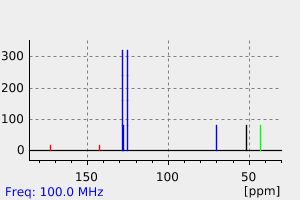3-羟基-3-苯基丙酸甲酯 | 7497-61-2
中文名称
3-羟基-3-苯基丙酸甲酯
中文别名
甲基(R)-3-羟基-3-苯基丙酸;(r)-3-羟基-3-苯丙酸甲酯
英文名称
methyl 3-hydroxy-3-phenylpropionate
英文别名
methyl 3-hydroxy-3-phenylpropanoate;methyl 3-phenyl-3-hydroxypropionate
CAS
7497-61-2
化学式
C10H12O3
mdl
MFCD19691249
分子量
180.203
InChiKey
VZHHCQFCDCJKIX-UHFFFAOYSA-N
BEILSTEIN
——
EINECS
——
-
物化性质
-
计算性质
-
ADMET
-
安全信息
-
SDS
-
制备方法与用途
-
上下游信息
-
文献信息
-
表征谱图
-
同类化合物
-
相关功能分类
-
相关结构分类
计算性质
-
辛醇/水分配系数(LogP):0.9
-
重原子数:13
-
可旋转键数:4
-
环数:1.0
-
sp3杂化的碳原子比例:0.3
-
拓扑面积:46.5
-
氢给体数:1
-
氢受体数:3
上下游信息
-
上游原料
中文名称 英文名称 CAS号 化学式 分子量 (+)-乙基 (R)-3-羟基-3-苯丙酸盐 3-hydroxy-3-phenylpropionic acid ethyl ester 72656-47-4 C11H14O3 194.23 3-羟基-3-苯丙酸 3-hydroxy-3-phenylpropanoic acid 3480-87-3 C9H10O3 166.177 —— ethyl 3-<(trimethylsilyl)oxy>-3-phenylpropanoate 130866-21-6 C13H20O3Si 252.386 3-(乙酰氧基)-3-苯基丙酸甲酯 methyl 3-(acetyloxy)-3-phenylpropanoate 90104-62-4 C12H14O4 222.241 2-苯基环氧乙烷-1-羧酸甲酯 methyl 3-Phenylglycidate 37161-74-3 C10H10O3 178.188 1,4-二羟基-4-苯基丁烷-2-酮 1,4-Dihydroxy-4-phenyl-2-butanone 83670-90-0 C10H12O3 180.203 苯甲酰乙酸甲酯 methyl 3-oxo-3-phenylpropionate 614-27-7 C10H10O3 178.188 -
下游产品
中文名称 英文名称 CAS号 化学式 分子量 甲基(R)-3-羟基-3-苯基丙酸 methyl (R)-3-hydroxy-3-phenylpropanoate 58692-70-9 C10H12O3 180.203 (S)-3-羟基-3-苯基丙酸甲酯 methyl (S)-3-hydroxy-3-phenylpropionate 36615-45-9 C10H12O3 180.203 β-羟基苯丙酸乙酯 Ethyl 3-hydroxy-3-phenylpropanoate 5764-85-2 C11H14O3 194.23 3-羟基-3-苯丙酸 3-hydroxy-3-phenylpropanoic acid 3480-87-3 C9H10O3 166.177 —— 3-Ethoxy-3-phenyl-propionsaeure-methylester 59403-47-3 C12H16O3 208.257 1-苯基-1,3-丙二醇 1-phenyl-1,3-propanediol 4850-49-1 C9H12O2 152.193 3-(乙酰氧基)-3-苯基丙酸甲酯 methyl 3-(acetyloxy)-3-phenylpropanoate 90104-62-4 C12H14O4 222.241 —— 3-hydroxy-3-phenylpropionamide 24506-17-0 C9H11NO2 165.192 —— (R)-3-hydroxy-3-phenylpropanamide 24506-17-0 C9H11NO2 165.192 —— β-Phenoxyhydrozimtsaeuremethylester 32191-64-3 C16H16O3 256.301 —— (+)-methyl 3-phenyl-3-hexanoyloxy-propionate 138307-06-9 C16H22O4 278.348 rac-3-甲基-1-苯基丁烷-1,3-二醇 (±)-1-methyl-4-phenylbutane-2,4-diol 104174-42-7 C11H16O2 180.247 —— (S)-3-hydroxy-3-phenyl-propionic acid ethylamide 96328-00-6 C11H15NO2 193.246 苯甲酰乙酸甲酯 methyl 3-oxo-3-phenylpropionate 614-27-7 C10H10O3 178.188 - 1
- 2
反应信息
-
作为反应物:描述:参考文献:名称:用于 α- 和 β- 羟基酸位点选择性和立体发散合成的多功能生物催化 C(sp3)−H 氧官能化摘要:在此,α-酮戊二酸依赖性芳氧基链烷酸双加氧酶(AAD)被重新用于生物催化氧功能化中的应用。天然 AAD 的活性分析使得四种类型的α-和β-羟基酸的合成具有广泛、高效和良好的选择性。DOI:10.1002/anie.202305250
-
作为产物:描述:参考文献:名称:(R)-和(S)-2-乙酰氧基-1,1,2-三苯乙醇-手性乙酸烯醇酯的有效合成当量摘要:通过(R)-2-乙酰氧基-1,1,2-三苯乙醇(5)的双重去质子化作用容易获得的烯醇化物3以高度立体选择性的方式添加到醛中。加合物6/7的水解产生酸2。DOI:10.1016/s0040-4039(01)91110-4
文献信息
-
Visible-Light-Driven, Metal-Free Divergent Difunctionalization of Alkenes Using Alkyl Formates作者:Ming Zheng、Jing Hou、Le-Wu Zhan、Yan Huang、Ling Chen、Li-Li Hua、Yan Li、Wan-Ying Tang、Bin-Dong LiDOI:10.1021/acscatal.0c04332日期:2021.1.15difunctionalization of alkenes has received considerable attention as an efficient and straightforward way to increase molecular complexity. However, examples of the difunctionalization of alkenes initiated by the intermolecular addition of alkoxycarbonyl radicals providing substituted alkanoates are still rare. Herein, we present the visible light-driven metal-free divergent difunctionalization of alkenes triggered
-
Oxidation of benzylsilanes and benzyltins by oxovanadium(V) compound and molecular oxygen作者:Toshikazu Hirao、Chihiro Morimoto、Takashi Takada、Hidehiro SakuraiDOI:10.1016/s0040-4020(01)00352-0日期:2001.6Benzylsilane and benzyltin compounds were oxidized by oxovanadium(V) compound under an oxygen atmosphere to afford the corresponding aromatic aldehydes (ketones) and/or carboxylic acids. In the reaction of benzyltins, oxovanadium(V) compound can be reduced to 0.5 molar amounts. The reaction of benzylsilanes is considered to proceed via electron-transfer process. On the other hand, benzyltins may undergo
-
One-pot enol silane formation-Mukaiyama aldol reactions: Crossed aldehyde-aldehyde coupling, thioester substrates, and reactions in ester solvents作者:C. Wade Downey、Grant J. Dixon、Jared A. Ingersoll、Claire N. Fuller、Kenneth W. MacCormac、Anna Takashima、Rohina SediquiDOI:10.1016/j.tetlet.2019.151192日期:2019.10Trimethylsilyl trifluoromethanesulfonate (TMSOTf) and a trialkylamine base promote both in situ enol silane/silyl ketene acetal formation and Mukaiyama aldol addition reactions between a variety of reaction partners in a single reaction flask. Isolation of the required enol silane or silyl ketene acetal is not necessary. For example, crossed aldol reactions between α-disubstituted aldehydes and non-enolizable
-
Development of an axially chiral sp3P/sp3NH/sp2N-combined linear tridentate ligand—fac-selective formation of Ru(II) complexes and application to ketone hydrogenation作者:Tomoya Yamamura、Satoshi Nakane、Yuko Nomura、Shinji Tanaka、Masato KitamuraDOI:10.1016/j.tet.2016.02.007日期:2016.6A newly developed chiral linear tridentate ligand, R-PN(H)N (R=H or Ph), possesses Ph2P and PyCH2NH groups at C(2) and C(2′) positions of the 1,1′-binaphthyl skeleton without or with a C(3)-Ph substituent. The steric effect of C(3)-Ph and the electronic effect of the DMSO co-ligand realize the facial selective generation of fac-RuCl2(Ph-PN(H)N)(dmso) and fac-[Ru(H-PN(H)N)(dmso)3](BF4)2, respectively一种新开发的手性线性三齿配体R-PN(H)N(R = H或Ph),在1,1'的C(2)和C(2')位置具有Ph 2 P和PyCH 2 NH基团-具有或没有C(3)-Ph取代基的-萘基骨架。C(3)-Ph的空间效应和DMSO共配体的电子效应实现了fac -RuCl 2(Ph-PN(H)N)(DMSO)和fac- [Ru(H- PN(H)N)(DMSO)3 ](BF 4)2。H-Ru advantageoussp 3 N-H反应位点负责给体-受体双功能催化剂(DACat)和围栏/平面手性环境,均通过以下优点构建:i)sp3 P,sp 3 N和sp 2 N的连接原子具有不同的电子性质;ii)DMSO反式至sp 3 N与Ru强烈配位,并被PyC(6)H = O S氢键固定 iii)单个NH功能简化了DACat反应位点。协同作用已成功地实现了对空间需求的酮的不对称氢化。还研究了R-PN(H)N第一行过渡金属配合物的结构特征。
-
Steric vs. electronic effects in the Lactobacillus brevis ADH-catalyzed bioreduction of ketones作者:Cristina Rodríguez、Wioleta Borzęcka、Johann H. Sattler、Wolfgang Kroutil、Iván Lavandera、Vicente GotorDOI:10.1039/c3ob42057d日期:——(LBADH) is an alcohol dehydrogenase that is commonly employed to reduce alkyl or aryl ketones usually bearing a methyl, an ethyl or a chloromethyl as a small ketone substituent to the corresponding (R)-alcohols. Herein we have tested a series of 24 acetophenone derivatives differing in their size and electronic properties for their reduction employing LBADH. After plotting the relative activity against短乳杆菌ADH(LBADH)是一种醇脱氢酶,通常用于将通常带有甲基,乙基或氯甲基作为小酮取代基的烷基或芳基酮还原为相应的(R)-酒精。本文中,我们已经测试了一系列24种苯乙酮衍生物,这些衍生物的大小和电子特性因使用LBADH的还原而不同。在绘制相对于测得的底物体积的相对活性后,我们观察到除底物尺寸外,其他影响也必须与所获得的活性有关。与苯乙酮相比(相对活性为100%),其他小底物如苯丙酮,α,α,α-三氟苯乙酮,α-羟基苯乙酮和苯甲酰基乙腈的相对活度低于30%,而中型酮(例如α-溴- ,α,α-二氯-和α,α-二溴苯乙酮的相对活性在70%至550%之间。此外,使用过量或仅2.5当量的酶活性与获得的最终转化率之间的比较。氢供体2-丙醇 再次表示它们之间的偏差。这些数据支持主要通过热力学控制这些氢转移(HT)转化。例如,即使使用2.5当量的LBADH,也可以定量还原庞大的α-卤代衍生物。与2-
表征谱图
-
氢谱1HNMR
-
质谱MS
-
碳谱13CNMR
-
红外IR
-
拉曼Raman
-
峰位数据
-
峰位匹配
-
表征信息
同类化合物
(R)-2-苯基-3-羟基丙酸
(2S,3R)-2,3-二羟基-3-(2-吡啶基)丙酸乙酯,N-氧化物
麦拉乳酸
阿拉伯碳酸氢二钾
铵;铈(+3)阳离子;(2R,3R)-2,3-二羟基丁烷二酸盐
钡二{8-[3-(2-羟基辛基)-2-环氧乙烷基]辛酸酯}
钠3-脱氧-D-阿拉伯糖-己酮酸酯
钠3-脱氧-D-木糖基-己酮酸酯
钠(3R,5R)-3,5-二羟基-7-[(1S,2S,6R,8S,8aR)-8-羟基-2,6-二甲基-1,2,6,7,8,8A-六氢-1-萘基]庚酸酯
钠(2S)-2-羟基(13C3)丙酸酯
酮酯
酒石酸锂单水合物
酒石酸铬
酒石酸铜(II)一水
酒石酸钾锑
酒石酸钾
酒石酸钠
酒石酸鐵(III)鉀
酒石酸辛酯钠盐
酒石酸羟吡啶
酒石酸氢钾
酒石酸异丙酯
酒石酸二磺基琥珀酰亚胺酯
酒石酸二琥珀酰亚胺酯
酒石酸二戊酯
酒石酸二仲丁酯
酒石酸二丙酯
辛酸,8-氯-6-羟基-,(6R)-
辛伐他汀钾盐
辛伐他汀钠盐
辛伐他汀酸
超支化BIS-MPA聚酯-64-羟基,4代
西托溴铵
表洛伐他汀羟基酸钠盐
葡萄糖酸镍
葡萄糖酸锶
葡萄糖酸锰
葡萄糖酸汞
葡萄糖酸亚铁
莫那可林J酸
苹果酸镁
苹果酸镁
苹果酸铵盐
苹果酸钙
苹果酸氢钠
苹果酸氢钠
苹果酸根
苹果酸二烯丙酯
苹果酸二乙基己酯
苹果酸乙酯(S)-2-羟基丁二酸1-乙酯(苹果酸杂质S)







